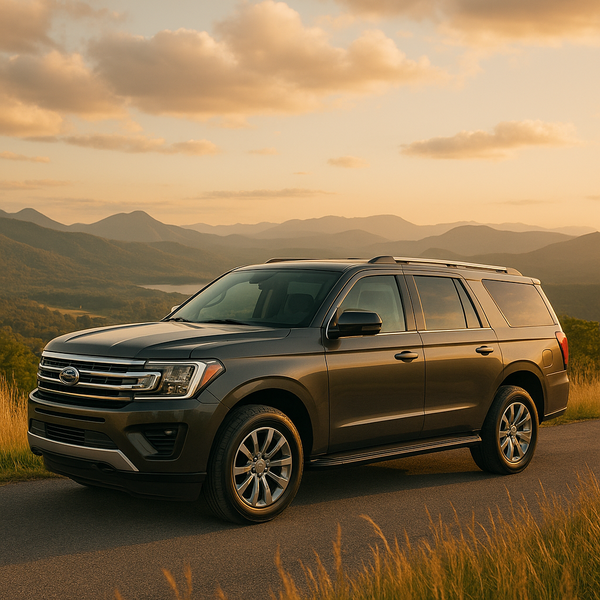
Large SUVs represent a significant segment of the automotive market, offering substantial space, powerful performance, and versatile capabilities. These vehicles are often chosen by families, adventurers, and anyone requiring considerable cargo space or towing power. Understanding their features and benefits is key to appreciating their role on the road today.
What Defines a Large SUV?
Large SUVs, often referred to as full-size SUVs, are typically built on a truck-based platform (body-on-frame) or a large car platform (unibody). This construction significantly impacts their ride quality, towing capacity, and overall durability. They are characterized by their generous interior dimensions, providing comfortable seating for up to seven, eight, or even nine passengers across three rows. Beyond passenger capacity, they offer expansive cargo areas, essential for luggage, groceries, or equipment for hobbies and work.
Key Features and Capabilities
One of the primary draws of a large SUV is its hauling capability. This includes not only interior cargo space but also significant towing capacities, often ranging from 5,000 to over 9,000 pounds. This makes them ideal for pulling boats, campers, or large trailers. Powertrain options typically involve powerful V6 or V8 engines, delivering the necessary torque for towing and hauling. Four-wheel drive or all-wheel drive systems are common, enhancing traction and capability in diverse weather conditions or off-road excursions.
Beyond brute strength, modern large SUVs are equipped with a wealth of features designed for comfort, convenience, and safety. Interior amenities often include premium upholstery, advanced infotainment systems with large touchscreens, navigation, multiple charging ports, and sophisticated climate control systems. Rear-seat entertainment systems are popular additions for keeping passengers engaged on long journeys. Safety features are paramount, with standard and available driver-assistance technologies such as adaptive cruise control, blind-spot monitoring, lane-keeping assist, automated emergency braking, and surround-view cameras.
Types of Large SUVs
Large SUVs can broadly be categorized based on their platform and intended use. Traditional full-size SUVs are typically body-on-frame, offering maximum towing and ruggedness. Examples include models often based on pickup truck platforms. These vehicles are known for their durable construction and ability to handle tough tasks, though their ride quality might be less refined than unibody alternatives.
Increasingly, large SUVs are also built on reinforced unibody platforms, similar to large sedans or crossovers. While they may sacrifice some maximum towing capacity compared to their truck-based counterparts, they often provide a more comfortable, car-like ride and improved fuel efficiency. These models are popular for families prioritizing passenger comfort and technology over heavy-duty hauling.
Another distinction can be made between mainstream large SUVs and luxury large SUVs. Luxury variants offer elevated levels of materials, craftsmanship, exclusive features, and more powerful engine options. They emphasize passenger comfort, advanced technology, and status, often coming with a higher price tag.
Choosing the Right Large SUV
Selecting the ideal large SUV depends heavily on individual needs and priorities. Buyers should consider their typical passenger load: Do you consistently need seating for eight, or is occasional third-row use sufficient? Towing requirements are critical; if you plan to tow heavy loads regularly, a body-on-frame model with a high towing capacity rating is likely necessary. Cargo space needs should be evaluated based on lifestyle – do you frequently transport bulky items, or is space for suitcases enough?
Fuel efficiency is another factor, though it's important to note that large SUVs are not inherently fuel-efficient due to their size and weight. However, advancements in engine technology and transmission design have led to improvements over older models. Budget is, of course, a major consideration, influencing not just the purchase price but also ongoing costs like fuel, insurance, and maintenance.
Furthermore, the specific features you desire play a significant role. Are advanced driver-assistance systems a priority for daily commuting? Is a premium audio system essential for road trips? Do you need off-road capability, or is the vehicle primarily for paved roads?
The Driving Experience
Driving a large SUV is a distinct experience. Their elevated driving position provides excellent visibility of the road ahead. Despite their size, many modern large SUVs are surprisingly maneuverable, thanks to advancements in steering and suspension design. However, parking in tight spaces and navigating narrow city streets can still present challenges compared to smaller vehicles. The ride quality varies depending on the platform; body-on-frame SUVs may feel more robust and truck-like, while unibody models offer a smoother, more isolated ride. On the highway, large SUVs typically provide a stable and comfortable cruising experience, soaking up bumps and providing a quiet cabin environment, especially in higher trims.
Maintenance and Ownership Costs
Owning a large SUV involves considering maintenance and operating costs. Given their larger engines and components, routine maintenance like oil changes, brake replacements, and tire wear can be more expensive than for smaller vehicles. Fuel costs are a significant factor due to lower MPG figures. Insurance premiums can also be higher due to the vehicle's value, repair costs, and potential for higher damage in accidents. However, for owners who genuinely need the space, capability, and security that a large SUV offers, these costs are often justified by the utility the vehicle provides.
In conclusion, large SUVs offer a compelling blend of space, capability, and modern features. Whether you need maximum passenger capacity, significant towing ability, or simply a commanding presence on the road, there's likely a large SUV that fits your requirements. Understanding the different types, key features, and ownership considerations is essential when exploring this substantial segment of the automotive market.

